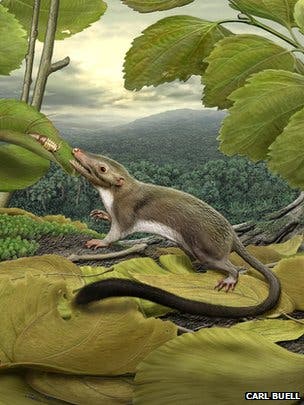For the past twenty years there’s been a debate whether the mammal explosion that eventually made the class of animals dominant on Earth happened before or after the end of the dinosaur reign. Scientific papers and various evidence supporting both views have surfaced along the years, but a recent massive study conducted by a collaborative team of scientists may have finally sealed this debate – according to their findings, the oldest placental mammal appeared some 200,000 years after the extinction event that saw the end of the dinosaurs. It was a rat-sized, insect-eating mammal.
Typically, paleontologists derive ancestry and links between species by studying phenotype – diet, lengths of limbs, shapes of teeth, length of fur if any, and so on. This is an extremely laborious process which implies manually measuring bones , detecting features and comparing anatomy with other species in order to move down the evolutionary tree – a process that hasn’t changed too much since the XIXth century.
“Anatomy and research in palaeontology had a very 19th Century veneer to it – that we would sit in small groups in a lab with a fossil describing it,” said lead author of the study Maureen O’Leary of Stony Brook University in New York, US.
“That is a very effective and important part of what we do, but by trying to bring this into the 21st Century and using new software, we were able to really band together as a group of experts and tackle a much larger problem,” she told BBC News.
Meet your oldest ancestor

The scientists gathered more than 4,500 details of phenotype from 86 different species that are around today, and from 40 fossils of extinct animals. In addition 12,000 detailed images and genetic information for all of the current species have been used and compiled in a massive database that is ten times larger than the nearest runner-up .
Still, we’re in the XIX century and besides making good use of genetics to establish and compare similarities across species, the researchers also employed a software that helped them put the pieces of the puzzle together. In the end, by noting which traits have been preserved down the lineage and how they are expressed, the researchers found that all placental mammals today – no marsupials (kangaroo) or egg laying mammals (platypus) – sprung from a common ancestor some 200,000 years after the dinosaurs went extinct. At its own end, this placental mammal most likely branched from older marsupial-like mammal types in South America and North America, rather than in Africa, given the geologic timing of events.
After the dinosaurs died off, a lot of open space and evolutionary niches were left right for the taking, and the mammals didn’t think twice about it. So, roughly 24 million generations later mammals went from mouse-size to elephant-size.
“With regards to evolution, it’s critical to understand the relationships of living and fossil mammals before asking questions about ‘how’ and ‘why,’ ” says Jonathan Bloch of the Florida Museum of Natural History.
“This gives us a new perspective of how major change can influence the history of life, like the extinction of the dinosaurs – this was a major event in Earth’s history that potentially then results in setting the framework for the entire ordinal diversification of mammals, including our own very distant ancestors.”
This common ancestor hasn’t been actually found, fossils and all, but based on the same information that allowed them to pinpoint the age, the scientists were also able to make some guesses on to how this animal might have looked like. By mapping the traits most strongly supported by the data, the researchers believe the oldest placental mammal ancestor had a two-horned uterus, a brain with a convoluted cerebral cortex and a placenta in which maternal blood came in close contact with membranes surrounding the fetus, as in humans.
Findings were documented in the journal Science.


